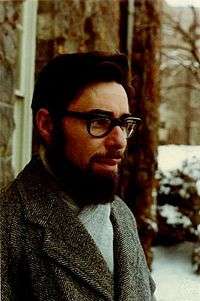Harry Kesten

Harry Kesten (19 November 1931, Germany) is an American mathematician best known for his work in probability, most notably on random walks and percolation theory.
Biography
Kesten grew up in the Netherlands, where he moved with his parents in 1933 to escape the Nazis. He received his Ph.D. in 1956 at Cornell University under supervision of Mark Kac. He was an instructor at Princeton University and the Hebrew University before returning to Cornell where he is now professor emeritus of mathematics.
Mathematical work
Kesten's work includes a number of fundamental contributions, including the following.
- Showing that amenability is equivalent to zero spectral gap and that a regular tree of degree
 has spectral radius
has spectral radius  [1]
[1] - His work with Hillel Furstenberg on products of random matrices[2]
- Enumerations of self-avoiding walks and a "pattern theorem".[3][4]
- Resolving a conjecture of Erdős and Szűsz on the discrepancy of irrational rotations[5]
- Kesten did much work on percolation including proving that the critical probability of bond percolation on the square lattice equals 1/2,[6] demonstrating the so-called scaling relations[7] and writing the first book on percolation directed towards mathematicians.[8]
- Giving an upper bound for the growth of arms in diffusion-limited aggregation[9]
- His work with Vladas Sidoravicius on the spread of an infection in a moving population[10][11]
Awards and honors
Kesten was a Guggenheim fellow, Alfred P. Sloan Fellow, received the Brouwer Medal in 1981, the Steele Prize[12] for Lifetime Achievement from the AMS, and the George Pólya Prize from the SIAM. He is also a member of the National Academy of Sciences and a correspondent member of the Royal Netherlands Academy of Arts and Sciences.[13] In 2012 he became a fellow of the American Mathematical Society.[14]
Selected works
- with Mark Kac: "On rapidly mixing transformations and an application to continued fractions". Bull. Amer. Math. Soc. 64 (5): 283–287. 1958. doi:10.1090/s0002-9904-1958-10226-8. MR 0097114; correction 65 1958 p. 67
- "Symmetric random walks on groups". Trans. Amer. Math. Soc. 92: 336–354. 1959. doi:10.1090/s0002-9947-1959-0109367-6. MR 0109367.
- "Occupation times for Markov and semi-Markov chains". Trans. Amer. Math. Soc. 103: 82–112. 1962. doi:10.1090/s0002-9947-1962-0138122-6. MR 0138122.
- Some probabilistic theorems on Diophantine approximations. Trans. Amer. Math. Soc. 103. 1962. pp. 189–217. doi:10.1090/s0002-9947-1962-0137692-1. MR 0137692.
- with Zbigniew Ciesielski: A limit theorem for the fractional parts of the sequence {2kt}. Proc. Amer. Math. Soc. 13. 1962. pp. 596–600. doi:10.1090/s0002-9939-1962-0138612-1. MR 0138612.
- with D. Ornstein and F. Spitzer: "A general property of random walk". Bull. Amer. Math. Soc. 68 (5): 526–528. 1962. doi:10.1090/s0002-9904-1962-10808-8. MR 0142160.
- "A convolution equation and hitting probabilities of single points for processes with stationary independent increments". Bull. Amer. Math. Soc. 75 (3): 573–578. 1969. doi:10.1090/s0002-9904-1969-12245-7. MR 0251797.
- "Some linear stochastic growth models". Bull. Amer. Math. Soc. 77 (4): 492–511. 1971. doi:10.1090/s0002-9904-1971-12732-5. MR 0278404.
- Hitting probabilities for single points for processes of stationary independent increments. Memoirs of the AMS; 93. Providence, R.I.: AMS. 1969.
- "Sums of stationary sequences cannot grow slower than linearly". Proc. Amer. Math. Soc. 49: 205–211. 1975. doi:10.1090/s0002-9939-1975-0370713-4. MR 0370713.
- "Erickson's conjecture on the rate of d-dimensional random walk". Trans. Amer. Math. Soc. 240: 65–113. 1978. doi:10.1090/s0002-9947-1978-0489585-x. MR 489585.
- Percolation theory for mathematicians. Stuttgart: Birkhäuser. 1982. ISBN 3-7643-3107-0.[15]
- "What is Percolation?" (PDF). Notices AMS. 2006.
See also
References
- ↑ Harry Kesten, Symmetric random walks on groups. Trans. Amer. Math. Soc. 92 1959 336--354.
- ↑ Hillel Furstenberg and Harry kesten, Products of random matrices, Ann. Math. Statist. 31 (1960), 457–469.
- ↑ Harry Kesten, On the number of self-avoiding walks. J. Mathematical Phys. 4 1963 960--969.
- ↑ Harry Kesten, On the number of self-avoiding walks. II. J. Mathematical Phys. 5 1964 1128--1137.
- ↑ Harry Kesten (1966). "On a conjecture of Erdős and Szüsz related to uniform distribution mod 1". Acta Arith. 12: 193––212.
- ↑ Harry Kesten, The critical probability of bond percolation on the square lattice equals 1/2. Comm. Math. Phys. 74 (1980), no. 1, 41--59.
- ↑ Harry Kesten, Scaling relations for 2D-percolation. Comm. Math. Phys. 109 (1987), no. 1, 109--156.
- ↑ Harry Kesten (1982), Percolation Theory for Mathematicians
- ↑ Harry Kesten, How long are the arms in DLA? J. Phys. A 20 (1987), no. 1, L29--L33.
- ↑ Harry Kesten and Vladas Sidoravicius, The spread of a rumor or infection in a moving population. Ann. Probab. 33 (2005), no. 6, 2402–2462.
- ↑ Harry Kesten and Vladas Sidoravicius, A shape theorem for the spread of an infection. Ann. of Math. (2) 167 (2008), no. 3, 701–766.
- ↑ 2001 Steele Prizes, Volume 48, Number 4, Notices of the AMS, April 2001.
- ↑ "H. Kesten". Royal Netherlands Academy of Arts and Sciences. Retrieved 17 July 2015.
- ↑ List of Fellows of the American Mathematical Society, retrieved 2013-01-27.
- ↑ Wierman, John (1984). "Review: Percolation theory for mathematicians, by Harry Kesten" (PDF). Bull. Amer. Math. Soc. (N.S.) 11 (2): 404–409. doi:10.1090/s0273-0979-1984-15331-x.
External links
|